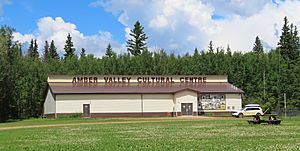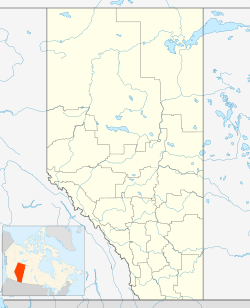Amber Valley, Alberta facts for kids
Quick facts for kids
Amber Valley
|
|
|---|---|
|
Unincorporated
|
|

Amber Valley Cultural Centre
|
|
| Country | Canada |
| Province | Alberta |
| Region | Northern Alberta |
| Census division | 13 |
| Municipal district | Athabasca County |
| Time zone | UTC-7 (MST) |
| • Summer (DST) | UTC-6 (MDT) |
Amber Valley is a small, undeveloped community in northern Alberta, Canada. It is about 160 kilometers (100 miles) north of Edmonton. The land here is about 608 meters (1,995 feet) above sea level.
Amber Valley was first called Pine Creek. It was one of several places in Alberta settled in the early 1900s. These settlers were Black immigrants from Oklahoma and the southern United States. Around 1,000 African Americans moved to Alberta between 1909 and 1911. Today, Amber Valley is home to the Obadiah Place provincial heritage site. This site is a preserved farm of one of the first African-American families who settled there.
History of Amber Valley
Between 1905 and 1912, African-American homesteaders started the community of Amber Valley. These settlers came from Oklahoma and Texas. They were looking for new opportunities. The Canadian government offered land to encourage people to settle and develop the area. The settlers were also leaving unfair conditions in the United States. These conditions, known as "Jim Crow" laws, limited their rights.
Henry Parson Sneed, a religious leader, guided a group of settlers from Oklahoma. They chose an area near the Athabasca River. The first few years were very hard. The climate was much colder than what they were used to in Oklahoma. They had to clear the land for farming. They also had to build their homes from scratch. Most of the first homes were simple log cabins.
Despite the challenges, the settlers were very determined. About three-quarters of the African Americans stayed on their land. They worked hard to develop it. This allowed them to officially own their homesteads. This was a higher success rate than some other settler groups. They built a school in 1913. A church was built in 1914. J.D. Edwards, one of the first settlers, started a baseball team. This team became well-known in the north.
Amber Valley was the largest Black community in Alberta until the 1930s. It got its own post office in 1931. This is when the community officially took the name Amber Valley. At that time, about 300 people lived there. The community also had a two-room schoolhouse. Over time, people started moving to bigger cities. They looked for more job opportunities. Because of this, the population declined. The post office closed in 1968.
Other Black settlements were also formed around this time. These included Junkins (now Wildwood), Keystone (now Breton), Campsie, and Eldon. From 1908 to 1911, about 1,000 African Americans moved to Alberta to start new lives.
Starting in the 1950s, many descendants of the original settlers moved. They went to cities like Edmonton. They wanted to escape the hard life of farming. They also sought better economic chances. In Edmonton, some Amber Valley descendants started the Shiloh Baptist Church. This is one of the few Black churches in Western Canada.
Today, Amber Valley is considered a ghost town. This means most people have moved away.
Original Settlers
Many brave people were among the first to settle in Amber Valley.
- Henry Parson Sneed arrived in 1905. He came with Jordon Murphy and Nimrod Toles.
- Jefferson Davis Edwards met Henry Parson Sneed on a train in 1910. He married Martha Murphy.
- Martha Murphy was the first woman to live in Amber Valley. Her son, Romeo, was the first child born there.
- Willace Bowen started a farm. His son, Obadiah Bowen, continued to work it. Obadiah built a new brick house in 1938. This house and farm, called Obadiah Place, is now a historic site. It shows the importance of the early settlers.
Other important original settlers include:
- John King and Stella King, who were the parents of Violet King Henry. She was the first Black female lawyer in Canada.
- Willace Bowen, also known as Willis Reese Bowen
- Henry Parson Sneed
- Hazel Proctor
- J.D. Edwards
Notable People
Many people with connections to Amber Valley have achieved great things:
- Oliver Bowen, who is the grandson of Willace Bowen, became an engineer.
- Cheryl Foggo is an author, documentary film director, and playwright.
- Violet King Henry, a descendant of the settlers, was the first Black female lawyer in Canada.
- Floyd Sneed was a drummer for the popular 1960s and 70s band Three Dog Night. He was born in Calgary and is related to Harrison Sneed.
- Judi Singh is a jazz singer with South Asian and Black heritage.
Popular Interest
Amber Valley's story has been shared in many ways:
- The community was featured in a 1984 documentary film. It was called We Remember Amber Valley and directed by Selwyn Jacob.
- Esi Edugyan's first novel, The Second Life of Samuel Tyne (2004), is set in a fictional town called Aster. This town is based on Amber Valley.
- In 2021, Canada Post honored the community with a special stamp.
- The Royal Canadian Mint created a silver coin to celebrate Amber Valley's original Black settlers. This coin was part of their Commemorating Black History series in 2024.


